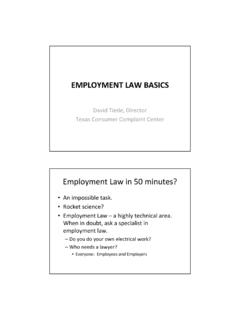Transcription of CANONS OF CONSTRUCTION (adapted from Scalia & Garner)
1 1 CANONS OF CONSTRUCTION (adapted from Scalia & Garner) SEMANTIC CANONS Ordinary-Meaning Canon. Words are to be understood in their ordinary, everyday meanings unless the context indicates that they bear a technical sense. Fixed-Meaning Canon. Words must be given the meaning they had when the text was adopted. Omitted-Case Canon. Nothing is to be added to what the text states or reasonably implies (casus omissus pro omisso habendus est). That is, a matter not covered is to be treated as not covered. General-Terms Canon.
2 General terms are to be given their general meaning (generalia verba sunt generaliter intelligenda). Negative-Implication Canon. The expression of one thing implies the exclusion of others (expressio unius est exclusio alterius). Mandatory/Permissive Canon. Mandatory words impose a duty; permissive words grant discretion. Conjunctive/Disjunctive Canon. And joins a conjunctive list, or a disjunctive list but with negatives, plurals, and various specific wordings there are nuances. Subordinating/Superordinating Canon.
3 Subordinating language (signaled by subject to) or superordinating language (signaled by notwithstanding or despite) merely shows which provision prevails in the event of a clash but does not necessarily denote a clash of provisions. Gender/Number Canon. In the absence of a contrary indication, the masculine includes the feminine (and vice versa) and the singular includes the plural (and vice versa). Presumption of Nonexclusive Include . The verb to include introduces examples, not an exhaustive list. Unintelligibility Canon.
4 An unintelligible text is inoperative. SYNTACTIC CANONS Grammar Canon. Words are to be given the meaning that proper grammar and usage would assign them. Last-Antecedent Canon. A pronoun, relative pronoun, or demonstrative adjective generally refers to the nearest reasonable antecedent. Series-Qualifier Canon. When there is a straightforward, parallel CONSTRUCTION that involves all nouns or verbs in a series, a prepositive or postpositive modifier normally applies to the entire series. 2 Nearest-Reasonable-Referent Canon.
5 When the syntax involves something other than a parallel series of nouns or verbs, a prepositive or postpositive modifier normally applies only to the nearest reasonable referent. Proviso Canon. A proviso conditions the principal matter that it qualifies almost always the matter immediately preceding. Scope-of -Subparts Canon. Material within an indented subpart relates only to that subpart; material contained in unindented text relates to all the following or preceding indented subparts. Punctuation Canon.
6 Punctuation is a permissible indicator of meaning. CONTEXTUAL CANONS Whole-Text Canon. The text must be construed as a whole. Presumption of Consistent Usage. A word or phrase is presumed to bear the same meaning throughout a text; a material variation in terms suggests a variation in meaning. Surplusage Canon. If possible, every word and every provision is to be given effect (verba cum effectu sunt accipienda). None should be ignored. None should needlessly be given an interpretation that causes it to duplicate another provision or to have no consequence.
7 Harmonious-Reading Canon. The provisions of a text should be interpreted in a way that renders them compatible, not contradictory. General/Specific Canon. If there is a conflict between a general provision and a specific provision, the specific provision prevails (generalia specialibus non derogant). Irreconcilability Canon. If a text contains truly irreconcilable provisions at the same level of generality, and they have been simultaneously adopted, neither provision should be given effect. Predicate-Act Canon.
8 Authorization of an act also authorizes a necessary predicate act. Noscitur a sociis - Associated-Words Canon. Associated words bear on one another s meaning. Ejusdem Generis Canon. Where general words follow an enumeration of two or more things, they apply only to persons or things of the same general kind or class specifically mentioned (ejusdem generis). Distributive-Phrasing Canon. Distributive phrasing applies each expression to its appropriate referent (reddendo singula singulis). Prefatory-Materials Canon.
9 A preamble, purpose clause, or recital is a permissible indicator of meaning. Title-and-Headings Canon. The title and headings are permissible indicators of meaning. Interpretive-Direction Canon. Definition sections and interpretation clauses are to be carefully followed. 3 Absurdity Doctrine. A provision may be either disregarded or judicially corrected as an error (when the correction is textually simple) if failing to do so would result in a disposition that no reasonable person could approve. Principles Applicable Specifically to Governmental Prescriptions EXPECTED-MEANING CANONS Constitutional-Doubt Canon.
10 A statute should be interpreted in a way that avoids placing its constitutionality in doubt. Avoidance Canon (sometimes used interchangeably with above) - If a statute is susceptible to more than one reasonable CONSTRUCTION , courts should choose an interpretation that avoids raising constitutional problems. In the US, this canon has grown stronger in recent history. The traditional avoidance canon required the court to choose a different interpretation only when one interpretation was actually unconstitutional.










